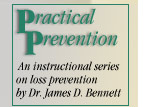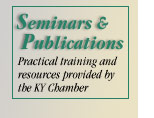

Article 1: LPS Overview | Article 2: Loss Investigations | Article 3: Loss Prevention Observations
| James D. Bennett, Ph.D., is an international loss prevention consultant for the petroleum, mining, manufacturing, and construction industries, as well as government organizations. He received a doctorate from The Pennsylvania State University where he was a faculty member in the Department of Mineral Engineering from 1974-1986, and Director of Earth and Mineral Sciences Continuing Education. Dr. Bennett was an executive with Exxon's El Cerrejon surface coal mine project in Colombia from 1986 - 1987. Since 1987 he has been in private practice as president of Loss Prevention Systems. Today, more than 60,000 employees and contractors use the Loss Prevention System in 65 countries located throughout North, South and Central America, Europe, Africa, and Asia Pacific. The system is also used in the Caribbean. Dr. Bennett is a U.S. Army veteran with service in Europe and Vietnam. |
This article covers the major points that should be addressed to develop and use investigations as a loss prevention tool to lower the cost of workers' compensation. The guidelines provided for each of these points are taken directly from successful industry experience in the use of this injury investigation tool. While these points do not cover the details of every step in the entire investigation process, the critical issues are outlined in a question and answer format.
"The first step in the development of an injury investigation system is to make decisions concerning the following seven questions. As each of these questions is answered, the organization must remember to keep in mind the key issue of "ownership and participation at all levels of the company," as discussed in the loss prevention overview article.
1. What types of injury cases should be investigated?
All injuries should be investigated, including reportable only and first aid cases with the potential for higher severity. The reason is that the causes of these relatively minor kinds of injuries are often identical to those factors associated with more serious injuries. So, if the organization identifies and eliminates the cause(s) of the less severe injuries, they can prevent the major injuries from occurring.
2. Who should conduct the investigation?
It's important to remember that all levels of the organization should have the opportunity for ownership as each loss prevention tool is developed. First, the safety manager should sit down with a cross section of hourly employees from all departments. In the session, the safety manager should explain the overall objectives of the investigation process and ask the group what they think their role should be for loss investigations. The safety manager should conduct the same kind of session with supervisors and another session with managers. After all levels of the organization have had an opportunity for input, operations management must make the final decision regarding the various investigation roles. What typically works most effectively is something like the following scenario:
3. When should the investigation be conducted?
In general, the investigation should be conducted as soon as reasonable for at least two reasons. First, more accurate information about the injury circumstances will be gathered if the investigation begins soon after the injury occurs. Second, if the investigation process is delayed, the message sent out to all employees is that the injury was not important to the organization. Intended or not, this obviously is not the message to convey.
"As soon as reasonable" means that the overriding factor as to how soon to conduct the investigation should be common business sense. In other words, the decision should be based on injury severity or potential injury severity. For example, if a person sustains a major injury, or if the injury is minor but potentially could have been much worse, and if the injury could happen again during the same or oncoming shift, the investigation needs to be completed immediately.
On the other hand, if the injury was minor and has the potential for nothing more than a minor injury, it is reasonable to delay the investigation until later in the shift or perhaps until the next day rather than stop a production process that would result in a larger loss. In any case, the investigation should be initiated within 24 hours of the injury occurrence. The preceding example represents a prudent business decision and certainly should not be interpreted as a safety compromise.
4. How do the investigators identify the root causes of the injury rather than deal with symptoms?
Any injury may have one or more root causes relating to the injured person, his/her peers, and the supervisor. These causes should be referred to as "personal factors." In addition, there may be root causes pertaining to the system within which the injured person was working. These causes should be referred to as "job factors." Investigators should ask the following questions in an attempt to identify the real root cause:
-- Lack of knowledge or skill.
-- Doing the job according to procedures or acceptable
practices takes more time and/or requires more effort.
-- Shortcutting procedures or acceptable practices is
positively reinforced or tolerated.
-- Did not follow procedures or acceptable practices in
the past and no incident occurred.
-- Lack of operational procedures or work standards.
-- Inadequate communication of expectations regarding
procedures or acceptable practices.
-- Inadequate tools or equipment.
The root cause(s) could be any one or a combination of these seven possibilities or some other external factor. In the vast majority of injury cases, the root cause is very much related to one or more of these seven factors.
5. How do investigators make solutions to prevent recurrence of the injury?
There are a couple of rules of thumb to follow when deciding what solutions to implement. In most cases, investigators should adhere to these guidelines:
6. What about communication of the injury?
What information about the injury investigation should be communicated? Who should prepare the information for communication? How, when, and by whom should this information be communicated?
-- A description of how the injury happened.
-- An explanation of why the injury occurred.
-- Identification of the root cause(s) of the injury.
-- Summary of the approved solution(s) that will be
implemented to eliminate the hazard.
7. What activities must be done in order to complete the investigation process?
The safety manager can most objectively evaluate the state of the solutions to verify implementation and validate effectiveness; therefore, he/she should be the one to perform these tasks.
Conclusion
When an organization implements an injury investigation system that thoroughly addresses the main points of these seven questions, and also adheres to the fundamental principles of ownership and participation at all levels of the organization, workers' compensation costs will be reduced as injury incidence and severity measures decline.
Copyright © 2002 Dr. James D. Bennett, Loss Prevention Systems
About KARE | Agent Locator | Regulatory News | Newsletter Archive
Policyholders | Agents | Why Choose KARE? | Contact Us | Home
Copyright © 2002 Kentucky Association of Responsible Employers. All rights reserved.
Questions or comments about this site? We welcome your feedback.
Experiencing technical difficulties? Contact our webmaster.
Site created & maintained by McBride Design


